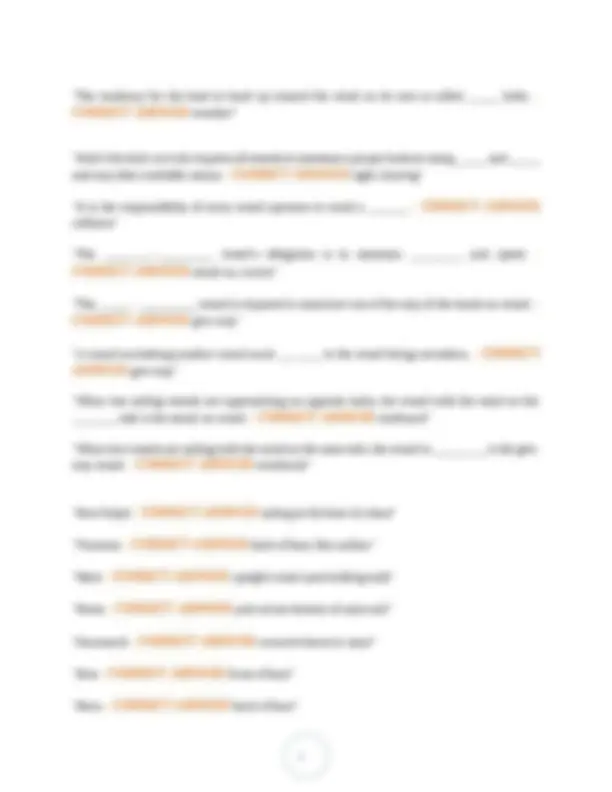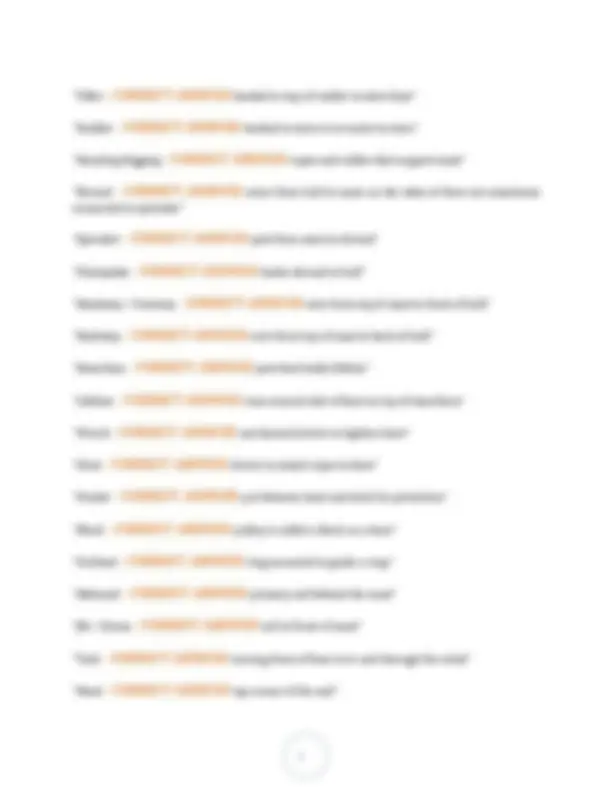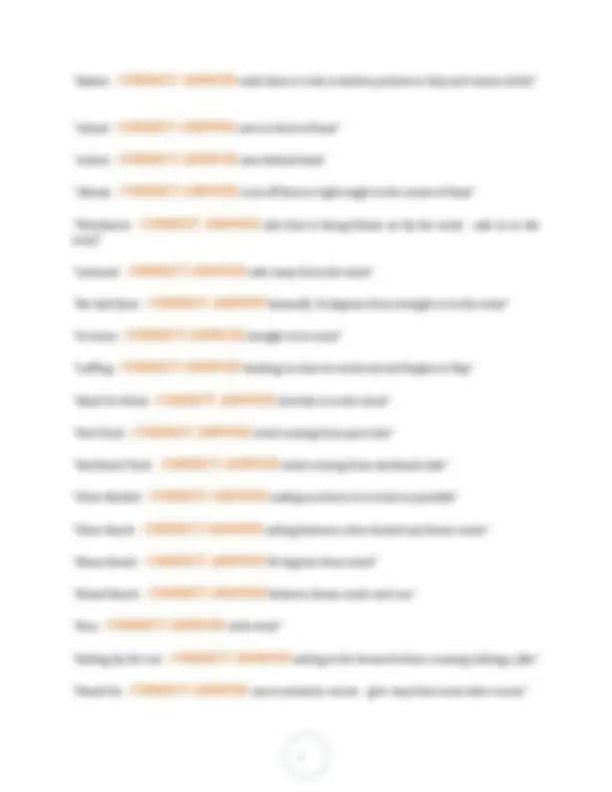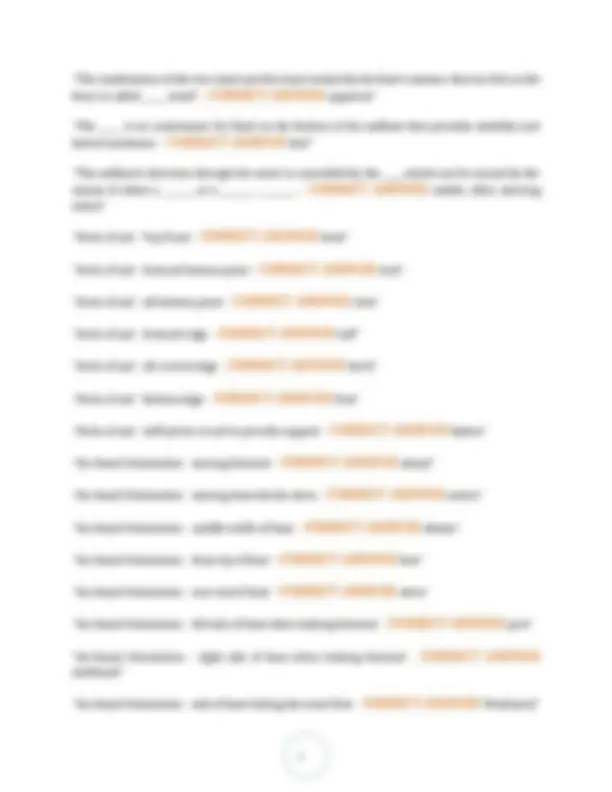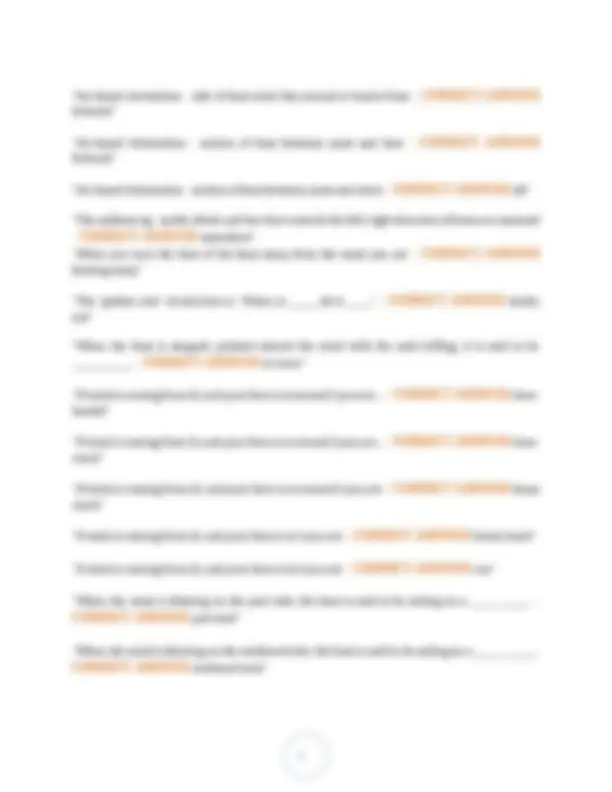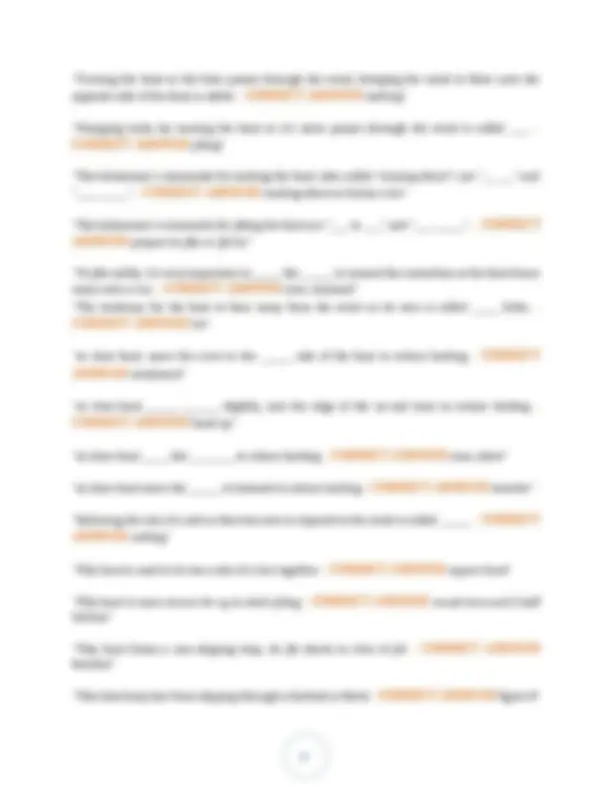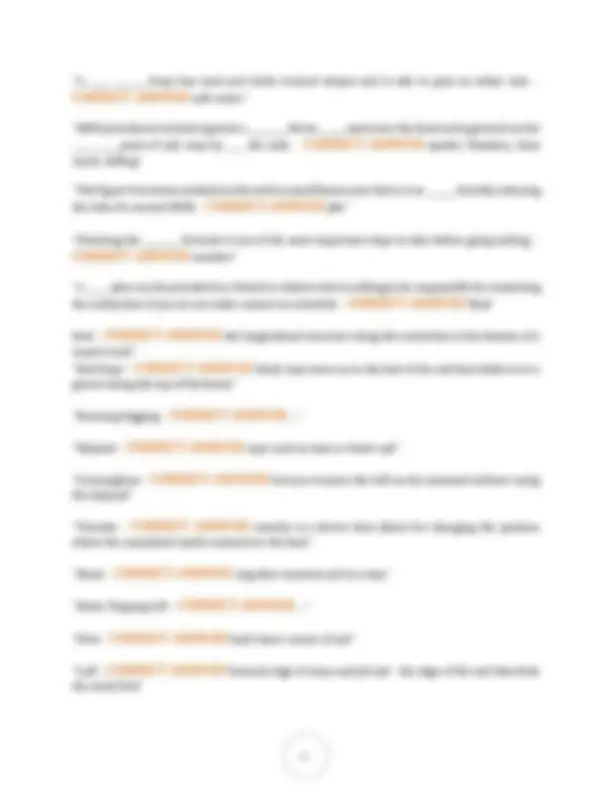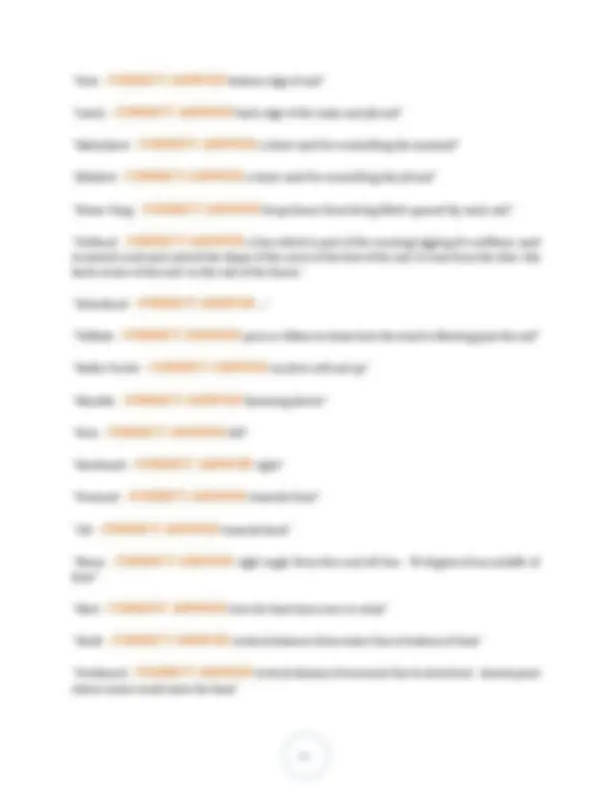Download ASA 101 QUESTIONS WITH EXPLANATIONS OF ANSWERS and more Exams Physical Activity and Sport Sciences in PDF only on Docsity!
ASA 101 QUESTIONS WITH EXPLANATIONS OF ANSWERS LATEST
UPDATE 2024.
“When sailing, always be aware of the wind's ___ and ___ - CORRECT ANSWER speed,
direction"
"The desirable force generated by the wind moving across a sail is called ______. - CORRECT
ANSWER lift"
"The direction relative to the wind in which the sailboat cannot sail is called the _____ ____ _____. -
CORRECT ANSWER no sail zone"
"The sailboat rig - where the boom and mast connect - CORRECT ANSWER gooseneck"
"The sailboat rig - block and tackle or solid pipe that hold down boom - CORRECT ANSWER
boom vang"
"The sailboat rig - line that lifts either mainsail or jib - CORRECT ANSWER haylard"
"The sailboat rig - line that connect to aft end of boom - CORRECT ANSWER Boom topping
lift"
"The sailboat rig - line that connects to the clew of the jib - CORRECT ANSWER jibsheet"
"The mainsail should be raised when the sailboat is oriented _____ to _____. - CORRECT
ANSWER head, wind"
"When turning the boat toward the wind, sails should be ___ in - CORRECT ANSWER
trimmed"
"When turning the boat away from the wind, the sails should be _________ out. - CORRECT
ANSWER eased"
""Fluttering" sails are said to be ______. - CORRECT ANSWER Luffing"
"The best way to steer the boat on a straight course is to look toward the ___ and pick a ___ to steer
toward - CORRECT ANSWER shore, landmark"
"When you turn the bow of the boat toward the wind you are - CORRECT ANSWER heading
up" "Sailing on a run with the mainsail and jib on opposite sides of the boat is called sailing ___ on ___
CORRECT ANSWER wing on wing"
"If the wind is on the same side of the boat as the mainsail while sailing downwind, the boat is
said to be ________ by the _______. - CORRECT ANSWER sailing by the lee"
"The danger of sailing by the lee is the increased risk of an___________ ___ - CORRECT ANSWER
accidental jibe"
"The fastest way to change the sail's power is to change its _____ to the _____. - CORRECT
ANSWER angle, wind"
"The shape of the mainsail my changed by adjusting tension in the edges of the sail. Outhaul
affects the - CORRECT ANSWER foot"
"The shape of the mainsail my changed by adjusting tension in the edges of the sail. Halyard or
downhaul cunningham affects the - CORRECT ANSWER luff"
"The shape of the mainsail my changed by adjusting tension in the edges of the sail. Boom vang
affects the - CORRECT ANSWER leech"
"The outhaul changes the depth of the ____ of the mainsail. - CORRECT ANSWER draft"
"Tightening the downhaul or cunningham moves the draft of the mainsail ______. - CORRECT
ANSWER forward"
"Tightening the ________ ________ holds the boom down on a downwind point of sail. - CORRECT
ANSWER boom vang"
"To get full power and optimum use of the mainsail, _____ it until is just starts to luff, then trim the
mainsail in so it just stops ______. - CORRECT ANSWER ease, trim"
"Change the sail's angle to the wind by - CORRECT ANSWER ease or trim the sail"
"Besides easing or trim the sail, change the sail's angle by - CORRECT ANSWER head-up or
bear away"
"Tiller - CORRECT ANSWER hooked to top of rudder to steer boat"
"Rudder - CORRECT ANSWER hooked to stern in to water to steer"
"Standing Rigging - CORRECT ANSWER ropes and cables that support mast"
"Shroud - CORRECT ANSWER wires from hull to mast on the sides of then oat sometimes
connected to spreader"
"Spreader - CORRECT ANSWER post from mast to shroud"
"Chainplate - CORRECT ANSWER hooks shroud to hull"
"Headstay / Forestay - CORRECT ANSWER wire from top of mast to front of hull"
"Backstay - CORRECT ANSWER wire from top of mast to back of hull"
"Stanchion - CORRECT ANSWER post that holds lifeline"
"Lifeline - CORRECT ANSWER runs around side of boat on top of stanchion"
"Winch - CORRECT ANSWER mechanical device to tighten lines"
"Cleat - CORRECT ANSWER device to attach ropes to boat"
"Fender - CORRECT ANSWER put between boat and dock for protection"
"Block - CORRECT ANSWER pulley is called a block on a boat"
"Fairlead - CORRECT ANSWER ring mounted to guide a roap"
"Mainsail - CORRECT ANSWER primary sail behind the mast"
"Jib / Genoa - CORRECT ANSWER sail in front of mast"
"Tack - CORRECT ANSWER turning front of boat in to and through the wind"
"Head - CORRECT ANSWER top corner of the sail"
"Batten - CORRECT ANSWER solid slats or rods in batten pockets to help sail retain airfoil"
"Ahead - CORRECT ANSWER area in front of boat"
"Astern - CORRECT ANSWER area behind boat"
"Abeam - CORRECT ANSWER area off boat at right angle to the center of boat"
"Windward - CORRECT ANSWER side that is being blown on by the wind - side in to the
wind"
"Leeward - CORRECT ANSWER side away from the wind"
"No-Sail Zone - CORRECT ANSWER basically 45 degrees from straight in to the wind"
"In Irons - CORRECT ANSWER straight in to wind"
"Luffing - CORRECT ANSWER heading to close to wind and sail begins to flap"
"Head To Wind - CORRECT ANSWER directly in to the wind"
"Port Tack - CORRECT ANSWER wind coming from port side"
"Starboard Tack - CORRECT ANSWER wind coming from starboard side"
"Close Hauled - CORRECT ANSWER sailing as direct in to wind as possible"
"Close Reach - CORRECT ANSWER sailing between close hauled and beam reach"
"Beam Reach - CORRECT ANSWER 90 degrees from wind"
"Broad Reach - CORRECT ANSWER between beam reach and run"
"Run - CORRECT ANSWER with wind"
"Sailing by the Lee - CORRECT ANSWER sailing to far leeward when running risking a jibe"
"Stand On - CORRECT ANSWER must maintain course - give-way boat must alter course"
"Rules: appropriate actions when sailing in commercial traffic / danger signal - CORRECT
ANSWER ..."
"Rules: federally required equipment boat under 25' - CORRECT ANSWER life jackets, visual
and sound distress signal, fire extinguisher, throwable device, navigation lights,"
"Location and color of navigation lights - CORRECT ANSWER Port side front light red (port
wine is red), Starboard side front light green, white stern light"
"describe a float plan and where it should be submitted - CORRECT ANSWER give someone
names, cell numbers, description of boat, destination and when you will return"
"Identity and state purpose of lateral aids to navigation by color, shape and numbering -
CORRECT ANSWER red marks right side of channel returning from main waters (red right
return), green indicates left side of channel when returning, channel marked by numbers starting with 1 at beginning of channel"
"Identify safe water, information and regulatory markers - CORRECT ANSWER vertical red
and white stripes and a ball on top, or are round balls similarly striped, deployed in deep water where it is safe to approach from all sides, often mark seaward approach to a channel"
"When and to whom are boating accidents reported - CORRECT ANSWER ..."
"Blood Alcohol Limit - CORRECT ANSWER .08"
"Sailboats can reach an upwind destination by sailing a ____ course. - CORRECT ANSWER
zigzag"
"The point of sail at the edge of the no-sail zone is called ___ ___ - CORRECT ANSWER close-
hauled"
"A boat sailing across the wind is said to be - CORRECT ANSWER reaching"
"Sailing straight downwind is called ___ - CORRECT ANSWER running"
"As the sailboat's direction changes relative to the wind, so should the sail's _____ to the wind be
adjusted. - CORRECT ANSWER angle or trim"
"The combination of the true wind and the wind created by the boat's motion (that we feel on the
boat) is called _____ wind? - CORRECT ANSWER apparent"
"The _____ is an underwater fin fixed on the bottom of the sailboat that provides stability and
lateral resistance. - CORRECT ANSWER keel"
"The sailboat's direction through the water is controlled by the ____, which can be turned by the
means of either a _______ or a ________ ________. - CORRECT ANSWER rudder, tiller, steering
wheel"
"Parts of sail - Top Point - CORRECT ANSWER head"
"Parts of sail - forward bottom point - CORRECT ANSWER tack"
"Parts of sail - aft bottom point - CORRECT ANSWER clew"
"Parts of sail - forward edge - CORRECT ANSWER luff"
"Parts of sail - aft curved edge - CORRECT ANSWER leech"
"Parts of sail - bottom edge - CORRECT ANSWER Foot"
"Parts of sail - stiff pieces in sail to provide support - CORRECT ANSWER batten"
"On-board Orientation - moving forward - CORRECT ANSWER ahead"
"On-board Orientation - moving towards the stern - CORRECT ANSWER astern"
"On-board Orientation - middle width of boat - CORRECT ANSWER abeam"
"On-board Orientation - front tip of boat - CORRECT ANSWER bow"
"On-board Orientation - rear end of boat - CORRECT ANSWER stern"
"On-board Orientation - left side of boat when looking forward - CORRECT ANSWER port"
"On-board Orientation - right side of boat when looking forward - CORRECT ANSWER
starboard"
"On-board Orientation - side of boat hitting the wind first - CORRECT ANSWER Windward"
"Turning the boat so the bow passes through the wind, bringing the wind to blow onto the
opposite side of the boat is called: - CORRECT ANSWER tacking"
"Changing tacks by turning the boat so it's stern passes through the wind is called ____. -
CORRECT ANSWER jibing"
"The helmsman's commands for tacking the boat (also called "coming about") are "___ ___" and
"_____ ______" - CORRECT ANSWER reading about or helms a-lee"
"The helmsman's commands for jibing the boat are "____ to ____" and "____-______". - CORRECT
ANSWER prepare to jibe or jib-ho"
"To jibe safely, it's very important to ______ the _______ in toward the centerline as the boat bears
away onto a run. - CORRECT ANSWER trim, mainsail"
"The tendency for the boat to bear away from the wind on its own is called ______ helm. -
CORRECT ANSWER lee"
"at close-haul, move the crew to the _______ side of the boat to reduce heeling - CORRECT
ANSWER windward"
"at close-haul _______ ________ slightly, into the edge of the no-sail zone to reduce heeling -
CORRECT ANSWER head up"
"at close-haul ______ the __________ to reduce heeling - CORRECT ANSWER ease, sheet"
"at close-haul move the _______ to leeward to reduce heeling - CORRECT ANSWER traveler"
"Reducing the size of a sail so that less area is exposed to the wind is called _______ - CORRECT
ANSWER reefing"
"This knot is used to tie two ends of a line together - CORRECT ANSWER square knot"
"This knot is more secure tie-up to dock piling - CORRECT ANSWER round turn and 2 half
hitches"
"This knot forms a non-slipping loop, tie jib sheets to clew of jib - CORRECT ANSWER
bowline"
"This knot keep line from slipping through a fairlead or block - CORRECT ANSWER figure 8"
"This knot is good to secure a dock line to a horn cleat - CORRECT ANSWER cleat hitch"
"This knot will temporary tie-up a dock piling, attach fenders to stanchions - CORRECT
ANSWER clove hitch"
"when you want to break while sailing, you can make the boat lie _______-_________ - CORRECT
ANSWER hove-to"
"You can heave-to by backing the _______, easing the ______, and putting the _________ to leeward. -
CORRECT ANSWER jib, mainsail, helm (Tiller)"
"This are used to protect the hull from contact with the dock or other boats. - CORRECT
ANSWER fenders"
"This dock line secures the bow of the boat to the dock. - CORRECT ANSWER bow line"
"This dock line secures the stern of the boat to the dock. - CORRECT ANSWER stern line"
"This dock line keeps the boat from moving aft. - CORRECT ANSWER forward spring"
"This dock line keeps the boat from moving forward. - CORRECT ANSWER aft spring"
"The ideal point of sail to approach a mooring ball is on a _______. - CORRECT ANSWER close
reach"
"the best conditions under which to approach a dock under sail is _______ - CORRECT
ANSWER upwind approach"
"When a sailboat has its engine and in gear, it is defined as a ______-__________ vessel, regardless of
whether the sails are raised. - CORRECT ANSWER power-driven"
"A powerboat, not in a channel or restricted in its ability to maneuver, should __________ _______ to
a sailboat under sail, unless the sailboat is ________ the powerboat - CORRECT ANSWER give
way, overtaking" "When two power-driven vessels are meeting head-on, ________ boat is the stand-on vessel.
Instead, both vessels should alter course to __________ and pass port-to-port. - CORRECT
ANSWER neither, starboard"
"In a crossing situation, if powerboat A sees powerboat B on its starboard side, then powerboat A
shall __________ _____________. - CORRECT ANSWER give way"
"A _____ _______ buoy has read and white vertical stripes and is safe to pass on either side. -
CORRECT ANSWER safe water"
"MOB procedures include appoint a ________, throw _____, maneuver the boat and approach on the
_____ ____ point of sail, stop by ____ the sails. - CORRECT ANSWER spotter, flotation, close
reach, luffing" "The figure 8 recovery method works well on small boats since there is no ______, thereby reducing
the risk of a second MOB. - CORRECT ANSWER jibe"
"Checking the ________ forecast is one of the most important steps to take before going sailing. -
CORRECT ANSWER weather"
"A _____ plan can be provided to a friend or relative who is willing to be responsible for contacting
the authorities if you do not make contact on schedule - CORRECT ANSWER float"
Keel - CORRECT ANSWER the longitudinal structure along the centerline at the bottom of a
vessel's hull"
"Bolt Rope - CORRECT ANSWER think rope sewn on to the foot of the sail that slides in to a
groove along the top of the boom"
"Running Rigging - CORRECT ANSWER ..."
"Halyard - CORRECT ANSWER rope used to raise or lower sail"
"Cunningham - CORRECT ANSWER lets you tension the luff on the mainsail without using
the halyard"
"Traveler - CORRECT ANSWER traveler is a device that allows for changing the position
where the mainsheet tackle connects to the boat"
"Hank - CORRECT ANSWER ring that connects sail to a stay"
"Boom Topping Lift - CORRECT ANSWER ..."
"Clew - CORRECT ANSWER back lower corner of sail"
"Luff - CORRECT ANSWER forward edge of main and jib sail - the edge of the sail that feels
the wind first"
"Foot - CORRECT ANSWER bottom edge of sail"
"Leech - CORRECT ANSWER back edge of the main and jib sail"
"Mainsheet - CORRECT ANSWER a sheet used for controlling the mainsail"
"Jibsheet - CORRECT ANSWER a sheet used for controlling the jib sail"
"Boom Vang - CORRECT ANSWER keeps boom from being lifted upward by main sail"
"Outhaul - CORRECT ANSWER a line which is part of the running rigging of a sailboat, used
to extend a sail and control the shape of the curve of the foot of the sail. It runs from the clew (the back corner of the sail) to the end of the boom."
"Downhaul - CORRECT ANSWER ..."
"Telltale - CORRECT ANSWER yarn or ribbon to show how the wind is blowing past the sail"
"Roller Furler - CORRECT ANSWER on jib to roll sail up"
"Shackle - CORRECT ANSWER fastening device"
"Port - CORRECT ANSWER left"
"Starboard - CORRECT ANSWER right"
"Forward - CORRECT ANSWER towards front"
"Aft - CORRECT ANSWER towards back"
"Beam - CORRECT ANSWER right angle from fore and aft line - 90 degrees from middle of
boat"
"Heel - CORRECT ANSWER how far boat leans over in wind"
"Draft - CORRECT ANSWER vertical distance from water line to bottom of boat"
"Freeboard - CORRECT ANSWER vertical distance from water line to deck level - lowest point
where water could enter the boat"

